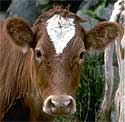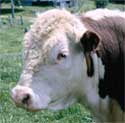 | Mad Cow Disease Detected for First Time in United States |
 | Mad Cow Disease Detected for First Time in United States |
|
By Ellen Kuwana Neuroscience for Kids Staff Writer December 24, 2003 Updated: December 31, 2003 A disease that eats holes in the brains of cows. Sounds like science fiction or a bad horror movie. Unfortunately, it's not fiction, and yesterday the Food and Drug Administration (FDA) reported the first suspected case of "mad cow disease" in the United States. A sample, sent to Great Britain for confirmation of the diagnosis, came back positive for mad cow disease on December 25, 2003. This sample, from a cow in Washington State, was from a "downer," an animal that is too sick to walk. The farm has been quarantined. | Washington
State |
Cow Brain |
Mad cow disease is more formally known as bovine spongiform encephalopathy (BSE). Bovine refers to cattle; spongiform comes from the sponge-like appearance the brain gets when the progressive disease creates clear holes in the brain's nerve cells; and encephalopathy refers to diseases of the brain from the word for brain, encephalo, and the word for disease, patho. |
|
BSE in cattle causes symptoms such as lack of coordination, aggression,
seizures, and tremors (shaking). Humans can get the disease by eating beef
that is contaminated with brain and spinal cord tissue, the parts of the
cow that are infectious. There is no evidence that the disease can be
transmitted in cow milk. The disease in humans is called Creutzfeldt-Jakob
disease (CJD) and is a degenerative disease of the central nervous system that usually strikes
people 55 years or older. The incubation period, the time between
infection and the appearance of symptoms, is long--up to 40 years for CJD.
This disease can occur spontaneously (unrelated to what one eats) or as a
result of eating contaminated beef. The spontaneous form of CJD accounts
for about 85% of the 200 cases each year in the US. Variant CJD
(vCJD) is
a more recently described form of CJD that strikes younger people. vCJD
has a shorter incubation time, approximately 8 years. Symptoms include
loss of coordination, personality changes, mania, and dementia similar to
Alzheimer's disease. It is widely believed that the cause of BSE is an infectious protein known as a prion (so named for "proteinaceous infectious particles"). Proteins can fold into various shapes, and different shapes have different functions. Prions have two forms: 1) one containing an alpha helix, referred to as "PrP," which is the normal, harmless form and 2) one containing a beta sheet, referred to as "PrPSc," which is the infectious form. Unlike other known infectious agents (for example, viruses), prions contain no genetic material. Dr. Stanley Prusiner won the Nobel prize in 1997 for his groundbreaking work on prions. | Central Nervous
System |
 | The US has been testing cattle for BSE since 1990, after
mad cow disease wreaked havoc on the British cattle industry in the 1990s.
In 1997, the FDA prohibited the use of animal meat and bone meal in cattle
feed in an attempt to prevent BSE in the US. In 2002, the FDA published a
contingency plan to deal with BSE in the United States. Experts emphasize that the food supply in the United States remains SAFE. This one case was seen in a dairy cow, and its nervous system tissue did not enter the food supply. This case is, literally, one in 100 million (100 million being the number of cattle in the US). This case could be a spontaneous case of CJD, or the result of diseased feed. On December 30, 2003, the US government prohibited tissue from downer cattle from entering the human food chain -- thus making the food supply safer. What previously seemed like a costly and unnecessary precaution now seems to make sense. |
| Did You Know?
|
|
References and Other Resources:
|
| BACK TO: | Neuroscience in the News | Exploring the Nervous System | Table of Contents |
![[email]](./gif/menue.gif) Send E-mail |
 Fill out survey |
 Get Newsletter |
 Search Pages |
 Take Notes |